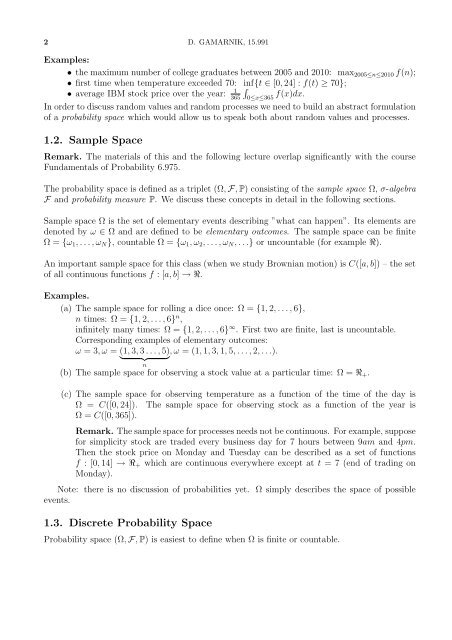Advanced Stochastic Processes.
Advanced Stochastic Processes.
Advanced Stochastic Processes.
Create successful ePaper yourself
Turn your PDF publications into a flip-book with our unique Google optimized e-Paper software.
2 D. GAMARNIK, 15.991<br />
Examples:<br />
• the maximum number of college graduates between 2005 and 2010: max 2005≤n≤2010 f(n);<br />
• first time when temperature exceeded 70: inf{t ∈ [0, 24] : f(t) ≥ 70};<br />
• average IBM stock price over the year:<br />
1<br />
365<br />
∫<br />
0≤x≤365 f(x)dx.<br />
In order to discuss random values and random processes we need to build an abstract formulation<br />
of a probability space which would allow us to speak both about random values and processes.<br />
1.2. Sample Space<br />
Remark. The materials of this and the following lecture overlap significantly with the course<br />
Fundamentals of Probability 6.975.<br />
The probability space is defined as a triplet (Ω, F, P) consisting of the sample space Ω, σ-algebra<br />
F and probability measure P. We discuss these concepts in detail in the following sections.<br />
Sample space Ω is the set of elementary events describing ”what can happen”. Its elements are<br />
denoted by ω ∈ Ω and are defined to be elementary outcomes. The sample space can be finite<br />
Ω = {ω 1 , . . . , ω N }, countable Ω = {ω 1 , ω 2 , . . . , ω N , . . .} or uncountable (for example R).<br />
An important sample space for this class (when we study Brownian motion) is C([a, b]) – the set<br />
of all continuous functions f : [a, b] → R.<br />
Examples.<br />
(a) The sample space for rolling a dice once: Ω = {1, 2, . . . , 6},<br />
n times: Ω = {1, 2, . . . , 6} n ,<br />
infinitely many times: Ω = {1, 2, . . . , 6} ∞ . First two are finite, last is uncountable.<br />
Corresponding examples of elementary outcomes:<br />
ω = 3, ω = (1, 3, 3 . . . , 5) , ω = (1, 1, 3, 1, 5, . . . , 2, . . .).<br />
} {{ }<br />
n<br />
(b) The sample space for observing a stock value at a particular time: Ω = R + .<br />
(c) The sample space for observing temperature as a function of the time of the day is<br />
Ω = C([0, 24]). The sample space for observing stock as a function of the year is<br />
Ω = C([0, 365]).<br />
Remark. The sample space for processes needs not be continuous. For example, suppose<br />
for simplicity stock are traded every business day for 7 hours between 9am and 4pm.<br />
Then the stock price on Monday and Tuesday can be described as a set of functions<br />
f : [0, 14] → R + which are continuous everywhere except at t = 7 (end of trading on<br />
Monday).<br />
Note: there is no discussion of probabilities yet. Ω simply describes the space of possible<br />
events.<br />
1.3. Discrete Probability Space<br />
Probability space (Ω, F, P) is easiest to define when Ω is finite or countable.
















